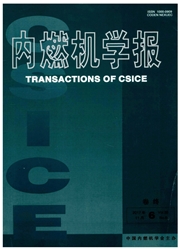

 中文摘要:
中文摘要:
废气再循环(EGR)、进气压力和喷油压力是影响柴油机低温燃烧的重要参数,主要研究了EGR对氮氧化物和颗粒排放的影响.结果表明,在一定工况条件下,随EGR率变大,NO所占体积分数呈先降低后升高的趋势,而N02和N20则呈先升高后降低的趋势.N20所占比例较小,峰值在1%左右.NO谷值与N02峰值对应相同的EGR率.随进气压力变大,N02所占比例峰值也变大,对应的EGR率也增加,进气压力为O.24MPa时,N02最大比例已接近60%.随EGR率增加,Soot排放快速升高时,颗粒发生积聚,颗粒数密度降低,但粒径变大.提高喷油压力可以降低颗粒排放,但在不同EGR率下,其降低颗粒的机理不同.
 英文摘要:
英文摘要:
Exhaust gas recirculation, boost and injection pressure are key parameters affecting diesel low temperature combustion. This paper investigates the effects of EGR on the nitrogen oxides and particulate emissions. The study shows that with the increase of EGR rate, the proportion of NO shows a decreasing and then increasing while those of NO2 and N20 give an opposite trend. The proportion of N20 is low with maximum value about 1%. The maximum proportion of NO2 and NO corresponds to the same EGR rate. With the increase of boost pressure, the peak proportion of NOz increases and its corresponding EGR rate also increases. At boost pressure of 0.24 MPa, the proportion of NO2 is 60%. When EGR rate is increased to the point where soot emission increases sharply, particulate conglomeration will occur, and its con- centration decreases but diameter increases. Higher injection pressure can decrease the particulate emission, but the mechanism is different at different EGR rates.
 同期刊论文项目
同期刊论文项目
 同项目期刊论文
同项目期刊论文
 Experimental and numerical study on suitable diesel fuel surrogates in low temperature combustion co
Experimental and numerical study on suitable diesel fuel surrogates in low temperature combustion co 期刊信息
期刊信息
